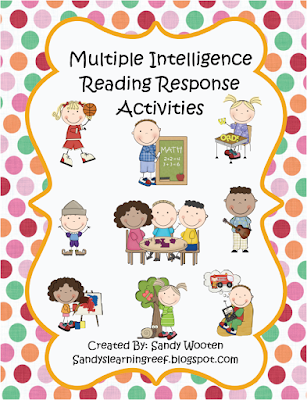This first activity is one of my favorites! As part of my Master's Degree program, I wrote my thesis on incorporating the multiple intelligence learning theory into reading instruction. I conducted my study for 6 weeks. For the first 3 weeks, we read stories and learned reading comprehension strategies in guided reading groups. Students completed a "traditional" book report worksheet (where students filled out information about their book such as characters, setting, plot, etc...) as their independent practice. At the end of the first half of my study, I assessed my students using the DRA. Only 29% of my students had "very good" comprehension, 64% had adequate comprehension, and 7% had "some" comprehension. I also had my students complete an attitudinal survey and leave comments about how they felt about reading. Only 2 students reported that they enjoyed reading and completing the independent practice activity. Students said they didn't like reading and the activity because it was boring, they were afraid of getting a bad grade on the activity, and one student actually said that it stressed them out. Who knew that a reading worksheet could cause these types of feelings in a second grader?
During the next 3 weeks, I taught guided reading using the same routine as above except my students were able to choose a Multiple Intelligence reading activity for their independent practice. Students were given a Multiple Intelligence survey to determine what type of "smart" they are before I conducted the second part of my study. Students were able to choose a retelling activity based on the type their type of "smart" or they were able to choose an activity that interested them for their independent practice (see below). At the end of the 3 weeks, 50% of my students had "very good" comprehension and 50% had "adequate" comprehension on the DRA assessment! 12 out of my 13 students reported that they enjoyed reading and completing the independent practice activities on their attitudinal survey. Under the comment section, students stated that they liked being able to choose their retelling activities, they liked knowing what type of "smart" they were, they felt proud of their work, and it was fun to present their retelling projects to the class. With comments like these, how could I stop using the MI theory in my classroom? Since my study, I continue to incorporate the MI retelling activities into my guided reading instruction. We usually set aside Friday afternoons as our time to share our retelling projects with the class.

The results from my study concluded that when students respond to text
according to their multiple intelligence learning style or are able to
choose a retelling activity that interests them, it not only increases
their comprehension of the story, but also increases their motivation to read
as well! If you are interested in learning more about the Multiple Intelligence Learning Theory, here are some additional resources you may want to check out: Multiple Intelligences in the Classroom by Thomas Armstrong, Multiple Intelligences: New Horizons in Theory and Practice by Howard Gardner, and Multiple Intelligences: The Complete MI Book by Spencer and Miguel Kagan.
Here are some examples story retelling activities my students created. Click here to get this pack to use with your students.
Tri-orama Story Summary.
Tri-orama Story Summary.
Story Box Display
These picture smart students created a "book box" or diorama of an important scene from the book and then wrote a summary of the story on an index card.
Here are some of my other favorite ideas I use as independent practice during my guided reading block. This leveled book activity box (above) from Lakeshore Learning has lots of different reading activities based on their guided reading level. My students also enjoy completing the activities from these two Scholastic resources "Instant Independent Reading Response Activities" by Laura Witmer (Grades2-4) and "Ready to Use Independent Reading Management Kit" by Scholastic (Grade 1, Grades 2-3, or Grades 4-6).










No comments:
Post a Comment